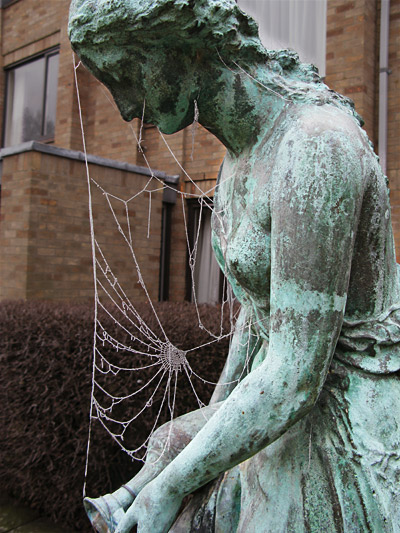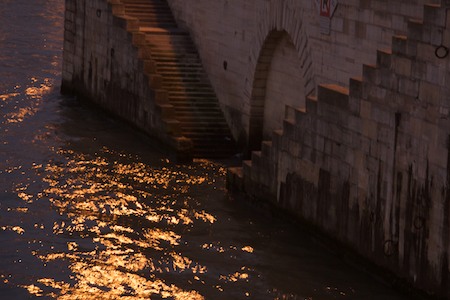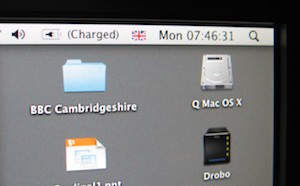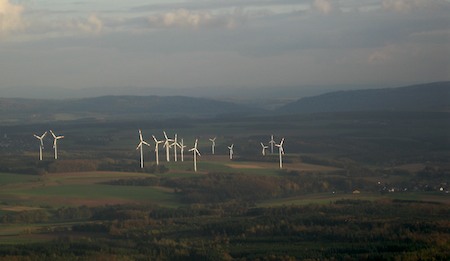This time, the River Cam, on a day when the water was unusually clear.

This time, the River Cam, on a day when the water was unusually clear.

If you’re a spider, and you rely on catching your prey by surprise, then a frost like yesterday’s must be rather inconvenient.

After a slightly hectic journey by Eurostar and Metro from a decidedly grey London this morning, we staggered up a final set of stairs and emerged, blinking, into bright Paris sunlight. The first thing we saw, quite literally, was Notre Dame looking as spectacular as ever. I leaned over the wall to take a photo, and my camera slipped out of my hand and bounced merrily down into the Seine.
Fortunately, it was only my backup camera – my little Ixus 750. I was rather fond of it – it has literally travelled everywhere with me for three years – but I was starting to think that it might need replacing before too long. It definitely needs replacing now!
Later, I took this photo quite close to its final resting place.

A quick hint: If you tag your photos with their GPS location (in the EXIF data), Flickr can put them on a map for you.
But it doesn’t do it automatically.
You need to enable it using the option on this page:
http://www.flickr.com/account/geo/exif/
Even then, it only does it for photos you upload from that point forward. I haven’t found a way yet to get it to make use of the lat and long I’ve been including in most of my photos for the last few months.
Still, this is a good start. I’ve re-uploaded my last batch and you can see the map here.
Many thanks to Chet.
Update: Here’s a script that can use the EXIF data restrospectively. Fabulous! Many thanks to Sam Judson!
A hint for photographers…
One of the things that encouraged me to switch to digital photography in the early days was the simple fact that all my photos were time-stamped. Now I can always sort images into the order in which they were taken – often the easiest way to find something – but I also have a rough chronological record of my life which can sometimes be very useful. If I want to remember when I was last in Paris, for example, I’ll almost certainly go and browse my photos to find out.
Usually, the timestamp doesn’t need to be very exact. I always have the camera set to GMT, wherever I am – changing timezones is too much trouble – but a few minutes of clock drift is not important. Recently, however, I’ve been geotagging my photos – a big post coming about that sometime soon – and precise timing can then be much more useful.
So if I’m about to upload photos from a camera on which I haven’t recently set the time, I’ll sometimes take a photo of the clock on my screen. This is synchronised with Apple’s NTP servers and so is one of the most accurate clocks in the house, and will be nicely in sync with the timestamps on my GPS receiver. Once the batch of photos is uploaded, I can use the difference between the camera’s timestamp and the time shown in the image to fix the timestamps on all the photos in the batch.

What’s more, once I’ve done the batch adjustment, I can refer back to the new timestamp on this image to make sure that it matches what’s on the screen and so confirm that I didn’t make a mistake.
Regularly setting the time on the camera is even better, but this is a fix for when you take the photos before remembering it!

The evening sun caught these wind turbines on Friday, just as we were descending into Frankfurth-Hahn airport.
I know some people consider them a blot on the landscape, but I’ve always thought them rather majestic.
If you visit Auschwitz-Birkenau, the thing that strikes you is the scale. You start at Auschwitz I, just down the road, where you hear about the various horrors. And then you visit Birkenau, and you realise that most of what you’ve just seen and heard about was really experimentation – they were just getting the small-scale process right so it could be expanded to an industrial scale.
It’s almost impossible to capture this in a photograph. Most of the original buildings were wooden and only their chimneys remain as evidence. Have a look at this close-up of the right hand side to get a feel for the size of just a portion of the site. I’d visited Yad Vashem in Jerusalem before, but this is something completely different.
Here’s the full-size version of the above panorama.
A tour of Auschwitz is not an easy experience. But it’s something everybody should do if they get a chance.
© Copyright Quentin Stafford-Fraser
Recent Comments